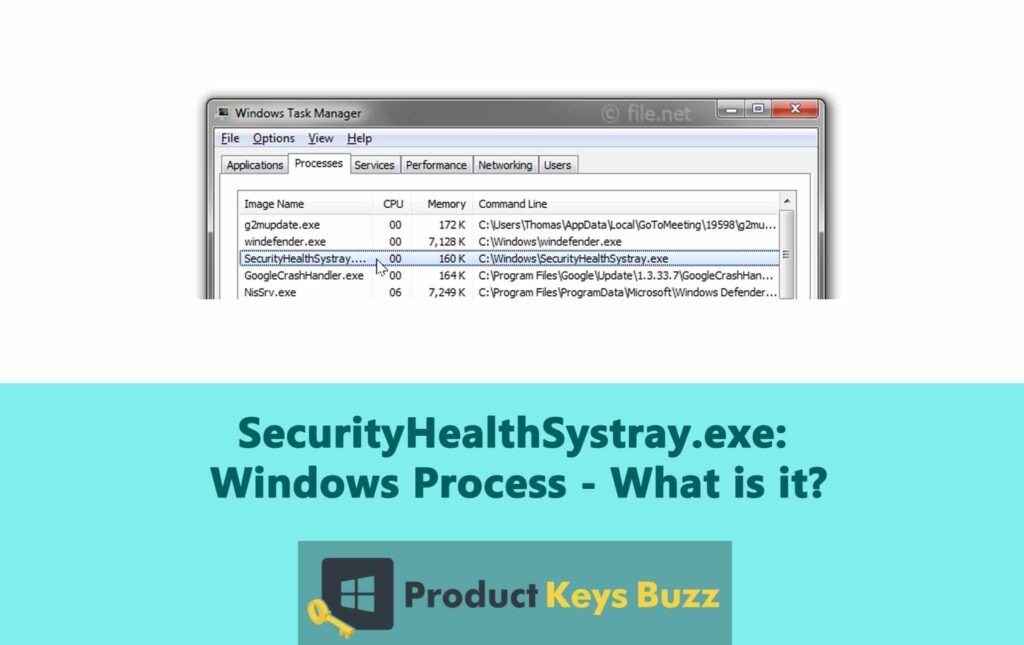As a Windows user, you must have noticed processes running in the background of your PC. Even if you don’t know what these processes are, they make an integral part of your system and are completely safe. That is unless a malware or virus is using the same process name.
Talking about Windows processes, some of you might have noticed SecurityHealthSystray.exe running in the background. Do you wonder what it is, or what it does? If so, you have come to the right place. This guide covers everything you need to know about SecurityHealthSystray.exe and if you should remove it.
What Is SecurityHealthSystray.exe?
SecurityHealthSystray.exe is an essential part of the Windows OS and is tied to the Windows Security software. This executable file is developed by Microsoft Corporation as a part of Windows Security. It supports the display of the Windows Security notification icon in the system tray.
Since SecurityHealthSystray.exe is a system file, it ensures the smooth functioning of Windows Security. It helps keep your device safe against potential threats like malware, viruses, and spyware. Additionally, it manages network protection, firewall, device health and performance, and browser control.
Without the SecurityHealthSystray.exe file, your PC’s security system cannot function properly. It provides security notifications, keeping you updated about potential threats that might impact your device.
While SecurityHealthSystray.exe is an important file and is worth keeping, it can sometimes cause problems like consuming too many resources. In this case, you might consider disabling the file for a temporary period to stabilise your system. However, deleting or removing the file from your PC is not recommended.
Should You Keep Or Remove SecurityHealthSystray.exe?
SecurityHealthSystray.exe is a 100% legit file, so there’s no need to delete or remove it without a reason. The file itself is safe and doesn’t pose a threat to your PC, so you can have it running in the background without worries.
However, if the file starts consuming too many resources, or creates other problems, then you must resolve it. Usually, the SecurityHealthSystray.exe file creates issues if it is corrupted or damaged. If the file is a virus or malware in disguise, it could be risky for your computer. In such situations, it is better to remove it from your system.
If you decide to disable the SecurityHealthSystray.exe file, you must follow these steps:
- Launch the Run dialogue box by pressing the Windows + R keys together.
- Enter regedit in the required box and hit the Enter button.
- Access the following path: HKEY_LOCAL_MACHINE\SOFTWARE\Microsoft\Windows\CurrentVersion\Run.
- Locate the SecurityHealthSystray.exe file in the right pane. Once you see the process, right-click on it, and choose Delete.
- After completing the above steps, close and exit the Registry Editor.
- Give your computer a restart to apply the changes made.
Note: You need to be very careful when editing the registry because even a minor mistake can mess up your entire system.
Is SecurityHealthSystray.exe A Virus/Malware?
SecurityHealthSystray.exe is a legitimate Windows process associated with Windows Defender. However, it’s important to be cautious because some malware may disguise itself with names similar to SecurityHealthSystray.exe to deceive users.
To determine if SecurityHealthSystray.exe is genuine, you should follow these steps:
- Run a Malware Scan: Use a reputable anti-virus tool to scan your system. This way you can identify and remove any suspicious files from your system.
- Verify File Location You should check the file’s location. If the file is genuine, it should be located in the C:\Windows\System32 folder. In case, you find the file in some other folder, it might be malware.
- Investigate Irregularities: If you notice any irregularities, such as a different file path or name variations, you should delete the file.
Taking these precautions will help you protect your system from malware and viruses.
Common Errors Associated With SecurityHealthSystray.exe
You may encounter several errors related to SecurityHealthSystray.exe. Some of the most common errors you should know about include:
- SecurityHealthSystray.exe Not Found
This error indicates that the file is either deleted or it is missing. This could prevent Windows Defender from functioning properly.
- High CPU Usage
This issue arises when SecurityHealthSystray.exe consumes an excessive amount of CPU resources. If this happens, it can cause your entire system to lag and slow down.
- Application Error
This message suggests there is a problem with the SecurityHealthSystray.exe file or the application itself. It often indicates that the file may be corrupt or not functioning as it is supposed to.
- SecurityHealthSystray.exe Has Stopped Working
This error occurs if the file encounters issues while running, possibly due to compatibility problems or memory issues.
- Access Violation
This error message appears if the SecurityHealthSystray.exe file is unable to access the memory location required. It indicates issues with file permissions or memory corruption.
Solutions To Fix Errors Related To SecurityHealthSystray.exe
If you are currently experiencing SecurityHealthSystray.exe related issues on your PC, no worries, we have the solution. There are a few things you can try to resolve the issue.
Before trying out any advanced troubleshooting steps, you should perform these initial checks:
- Restart Your Computer: A simple restart can often resolve minor issues.
- Use a Registry Cleaner: This can help fix any registry-related problems.
- Perform a Malware Scan: Use a reputable third-party antivirus tool to ensure your system is free from malware.
If these solutions don’t work, you can move on to the more advanced troubleshooting steps.
Solution 1: Update The Windows OS
Sometimes, updating your Windows OS to the latest version helps. For this, you need to follow these steps:
- Open the Windows Settings app by pressing the Windows + I key together.
- Access Windows Update and choose Check for Updates.
- If updates are available, select the Download button and install them on your device.
- Now you can update the Windows OS.
Solution 2: Run SFC & DISM Scans
This is another solution you can try to resolve the error.
- Start by pressing the Windows key and entering cmd. Then, choose Run as Administrator.
- Copy the given command and paste it into the repair system files. After that hit the Enter button.
sfc/scannow
- Give it a few minutes to complete. Once it’s done, enter the following command and hit the Enter button.
DISM /Online /Cleanup-Image /RestoreHealth
- After you are done with the above steps, you can restart your PC to apply the changes made.
Solution 3: Reset The Windows Security
You can also reset the Windows Security tool to fix this error. Here’s how:
- Launch the Settings app by pressing the Windows + I key at the same time.
- Access the Apps and choose Installed Apps.
- Find Windows Security and click the three dots right next to it. Next, choose Advanced options.
- Hit the Reset button.
- Confirm your decision by clicking on the Reset button again.
This will restore Windows Security to its default settings and also delete the app data. Completing these steps should resolve the issue. However, if the problem continues, you should seek professional help.
Solution 4: Perform System Restore
To restore the system, follow these steps:
- Press the Windows + R key to launch the Run console box.
- Enter sysdm.cpl and select OK. This will give you access to System Properties.
- Access the System Protection tab, and select the System Restore button.
- Select the “Choose the different restore point” option and choose Next.
- Specify the version to be restored and hit Next.
- Select Finish.
Final Words
SecurityHealthSystray.exe is a genuine file that plays a crucial role in maintaining your system’s security by integrating with Windows Defender. Although the file is safe, it’s important to stay aware as malware can sometimes disguise itself using similar names. If you encounter issues with the file, you can resolve them by following the solutions outlined in this post.
Table of Contents







